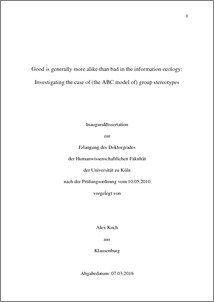Koch, Alex
(2016).
Good is generally more alike than bad in the information ecology: Investigating the case of (the ABC model of) group stereotypes.
PhD thesis, Universität zu Köln.

![[img]](https://kups.ub.uni-koeln.de/style/images/fileicons/application_pdf.png)  Preview |
|
PDF
DISSERTATION_DR._ALEX_KOCH.pdf
- Accepted Version
Download (2MB)
|
Abstract
On most if not all evaluatively relevant dimensions such as the temperature level, taste intensity, and nutritional value of a meal, one range of adequate, positive states is framed by two ranges of inadequate, negative states, namely too much and too little. This distribution of positive and negative states in the information ecology results in a higher similarity of positive objects, people, and events to other positive stimuli as compared to the similarity of negative stimuli to other negative stimuli. In other words, there are fewer ways in which an object, a person, or an event can be positive as compared to negative. Oftentimes, there is only one way in which a stimulus can be positive (e.g., a good meal has to have an adequate temperature level, taste intensity, and nutritional value). In contrast, there are many different ways in which a stimulus can be negative (e.g., a bad meal can be too hot or too cold, too spicy or too bland, or too fat or too lean). This higher similarity of positive as compared to negative stimuli is important, as similarity greatly impacts speed and accuracy on virtually all levels of information processing, including attention, classification, categorization, judgment and decision making, and recognition and recall memory. Thus, if the difference in similarity between positive and negative stimuli is a general phenomenon, it predicts and may explain a variety of valence asymmetries in cognitive processing (e.g., positive as compared to negative stimuli are processed faster but less accurately). In my dissertation, I show that the similarity asymmetry is indeed a general phenomenon that is observed in thousands of words and pictures. Further, I show that the similarity asymmetry applies to social groups. Groups stereotyped as average on the two dimensions agency / socio-economic success (A) and conservative-progressive beliefs (B) are stereotyped as positive or high on communion (C), while groups stereotyped as extreme on A and B (e.g., managers, homeless people, punks, and religious people) are stereotyped as negative or low on C. As average groups are more similar to one another than extreme groups, according to this ABC model of group stereotypes, positive groups are mentally represented as more similar to one another than negative groups. Finally, I discuss implications of the ABC model of group stereotypes, pointing to avenues for future research on how stereotype content shapes social perception, cognition, and behavior.
| Item Type: |
Thesis
(PhD thesis)
|
| Translated title: |
| Title | Language |
|---|
| Gutes ist einander ähnlicher als Schlechtes: Der Fall (des ABC-Modells der) Stereotype über Gruppen | German |
|
| Translated abstract: |
| Abstract | Language |
|---|
| Für viele Bewertungsdimensionen (z.B. die Temperatur, der Geschmack, und der Nährwert einer Mahlzeit) gilt: Ein Spektrum positive Zustände ist von zwei Spektren negativer Zustände umgeben: zu viel und zu wenig. Diese Verteilung von Zuständen in der Informationsökologie resultiert in einer höheren Ähnlichkeit positiver Objekte, Personen, und Ereignisse im Vergleich zu negativen Stimuli. Das heißt, es gibt weniger Möglichkeiten positiv zu sein als negativ zu sein. Stimuli können oftmals nur auf eine einzige Art und Weise positiv sein (z.B. bei einer guten Mahlzeit müssen sowohl die Temperatur als auch der Geschmack und der Nährwert angemessen sein). Stimuli können aber in vielerlei Hinsicht negativ sein (z.B. eine schlechte Mahlzeit kann zu heiß oder zu kalt, zu scharf oder zu fad, oder zu fett oder zu karg sein). Diese höhere Ähnlichkeit von positiver verglichen zu negativer Information ist relevant, weil Ähnlichkeit auf nahezu allen Ebenen der Informationsverarbeitung einen großen Einfluss auf Schnelligkeit und Genauigkeit hat. Wenn die höhere Ähnlichkeit von positiver verglichen zu negativer Information also ein allgemeingültiges Phänomen ist, dann könnte dieses Phänomen eine Reihe von Valenzasymmetrien in der Informationsverarbeitung vorhersagen / erklären. Ich zeige, dass die höhere Ähnlichkeit von positiver verglichen zu negativer Information in der Tat ein allgemeingültiges Phänomen ist, welches auf tausende Wörter und Bilder zutrifft. Außerdem zeige ich, dass die höhere Ähnlichkeit von positiver verglichen zu negativer Information auch auf soziale Gruppen zutrifft. Gruppen, welche hinsichtlich Durchsetzungskraft / soziökonomischer Status (A für agency) und konservative-progressive Überzeugungen (B für beliefs) als durchschnittlich beurteilt werden, werden hinsichtlich Gemeinschaftssinn (C für communion) als hoch beurteilt. Gruppen, welche hinsichtlich A und B als extrem beurteilt werden, werden hinsichtlich C als niedrig beurteilt. Da durchschnittliche Gruppen einander ähnlicher sind als extreme Gruppen, sind positive verglichen zu negativen Gruppen ähnlicher. Zum Abschluss diskutiere ich Implikationen dieses ABC-Modells von Gruppenstereotypen, wobei ich auf weiterführende Forschungsmöglichkeiten zum Einfluss von Stereotypen auf soziale Wahrnehmung, Kognition, und Verhalten hinweise. | German |
|
| Creators: |
| Creators | Email | ORCID | ORCID Put Code |
|---|
| Koch, Alex | alex.koch@uni-koeln.de | UNSPECIFIED | UNSPECIFIED |
|
| URN: |
urn:nbn:de:hbz:38-70899 |
| Date: |
6 December 2016 |
| Language: |
English |
| Faculty: |
Faculty of Human Sciences |
| Divisions: |
Faculty of Human Sciences > Department Psychologie |
| Subjects: |
Psychology |
| Uncontrolled Keywords: |
| Keywords | Language |
|---|
| valence asymmetries, mental representation, similarity, natural sampling, spatial arrangement, generality, stereotype content, groups, agency / socio-economic success, conservative-progressive beliefs, communion, ABC model | UNSPECIFIED |
|
| Date of oral exam: |
17 June 2016 |
| Referee: |
| Name | Academic Title |
|---|
| Unkelbach, Christian | Prof. Dr. | | Imhoff, Roland | Prof. Dr. |
|
| Refereed: |
Yes |
| URI: |
http://kups.ub.uni-koeln.de/id/eprint/7089 |
Downloads per month over past year
Export


